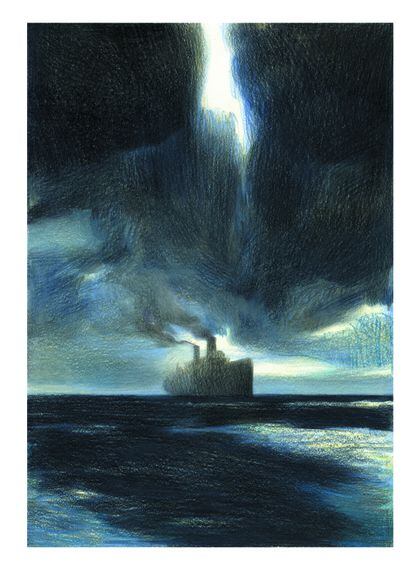A cartoon from 'Rhapsody in Blue', by Andrea Serio.
After a while, only the sea was visible. The land, Trieste and the life that Andrea Goldstein had known until then were left behind. Swallowed by the horizon. And by the delirium of a dictator. Suddenly, the country where the boy was born no longer wanted him. Not him, not his own. "World Judaism has been [...] an irreconcilable enemy of fascism," proclaimed Mussolini in September 1938, before the exalted masses. In November, Italy passed racial laws. And a year later Goldstein set sail for a brighter future in America. He started calling himself Andrew, found a job, a partner, and a new home. He noted, however, that his scars were not closing. So he enlisted in the army, got on another ship, and went the other way. Fascism, he decided, had to be fought closely. In the trenches.
More information
The 70 minutes that decided the fate of thousands of Italian Jews
"With his beauty, his youthful rebellion, his conscience, his impulsiveness and his courage, he seems the perfect hero of a tragic story," says cartoonist Andrea Serio.
But everything is real, as much as the letter that Goldstein sent from the front, in February 1943, to his cousin Cati and that closes the graphic novel
Rhapsody in Blue
(Sapristi).
It is precisely thanks to this correspondence that the odyssey of a young man willing to plunge into the horror of World War II to follow his ideals has been reconstructed.
First, the writer Silvia Cuttin narrated Goldstein's experiences in the novel
Ci sarebbe bastato
(It would have been enough for us)
.
And Serio, now, has drawn them.
A page from 'Rhapsody in Blue', by Andrea Serio.
"I believe that, through small, personal stories, it is possible to approach in a more concrete and direct way the events of history with a capital letter", defends the creator.
In reality, Mussolini's racist drift overwhelmed several members of the Goldstein family.
Martino, Andrea's cousin, was one of the few Italian Jews who managed to survive in Auschwitz, as
recounted
in
Ci sarebbe bastato
.
But, for his first graphic novel, Serio preferred a single protagonist and focus on his broken youth.
The title of the work alludes to the homonymous jazz symphony that George Gershwin composed in 1924. Because in that letter to his cousin Goldstein he said that, in addition to the usual noise of bullets, those days he was listening to just that melody. “At first, I thought about building the story on the structure of that composition, dividing it into eight movements, each with its own shade of blue. I resigned, with a certain sadness, when I realized that it was more than anything fun, ”Serio explains.
Even so, given the scarce presence of texts, it is as if during the reading the piano of
Rhapsody in Blue
resounded, between melancholic and nostalgic lines.
After all, it was a veteran and applauded cartoonist like Igort who commissioned Serio for the project and gave him some good advice: “He suggested that I stay 'dry', since my images were naturally infused with lyricism.
I wanted wide-format vignettes, where the sounds were suggested by the illustrations ”.
To complete the recipe for a good comic strip, the artist also quotes another of the most famous cartoonists in his country, Gipi: “Cultivate your freedom, your autonomy, your gaze and your voice.
And that money is your second thought, never the first ”.
Andrea Serio in a promotional image.
Even if
Rhapsody in Blue
also cultivates some outrage.
Because the final solution and the concentration camps weigh on the memory of Germany, but Italy also contributed to the extermination.
“And that is less documented.
We are talking about laws, promoted by the fascist government of Mussolini and signed by King Victor Manuel III that led to the elimination of almost 10,000 Italian citizens of the Jewish religion, most of them deported and murdered in Auschwitz ”, Serio recalls.
And he adds: “The attempt to review that infamous period by certain political forces in Italy has never been as strong as now.
You have to keep your guard up, and refute with the facts ”.
Sometimes a comic can also be a trench.
Andrea Goldstein, in 1943 Courtesy of Silvia Cuttin

